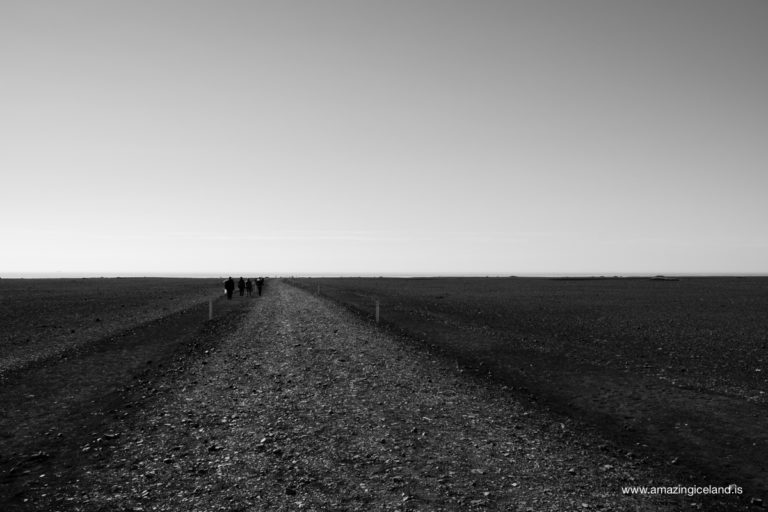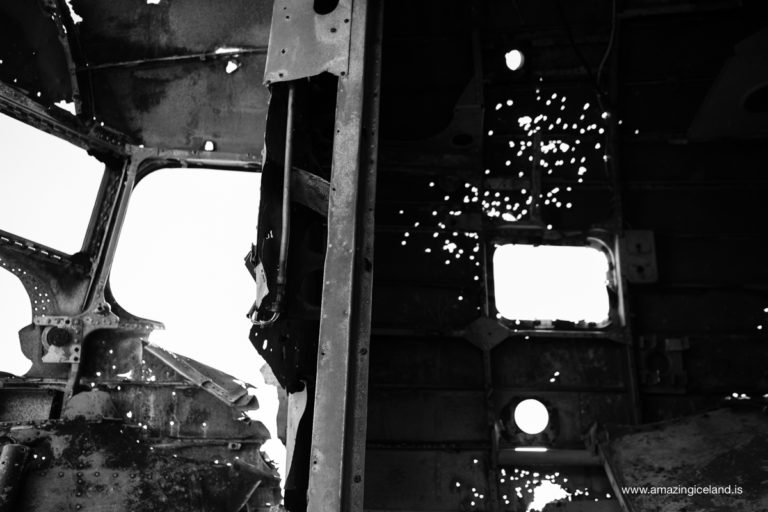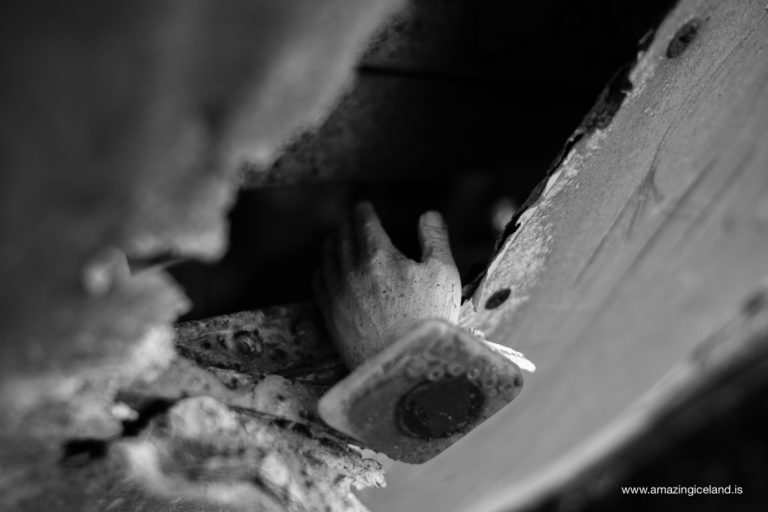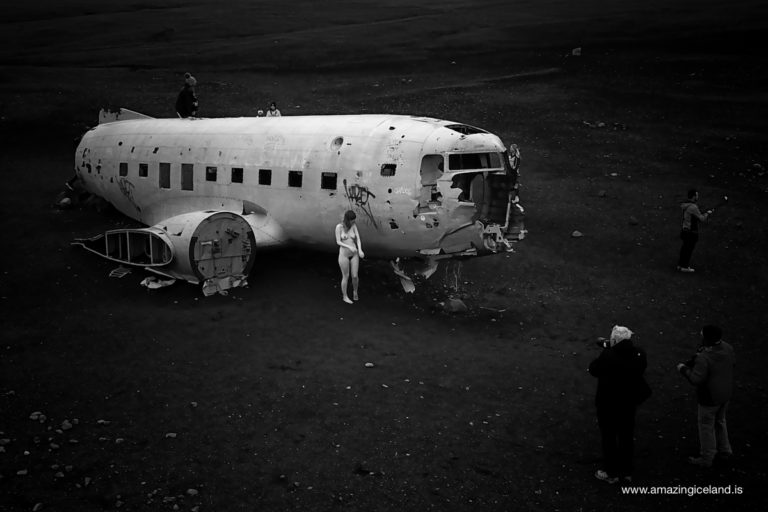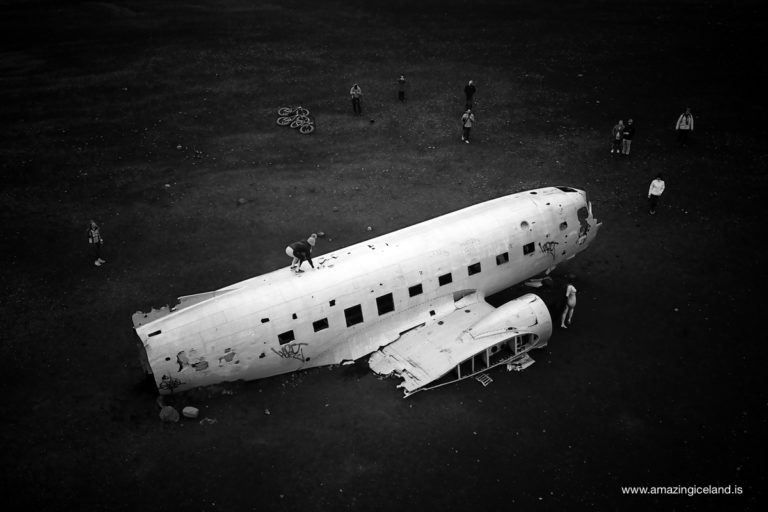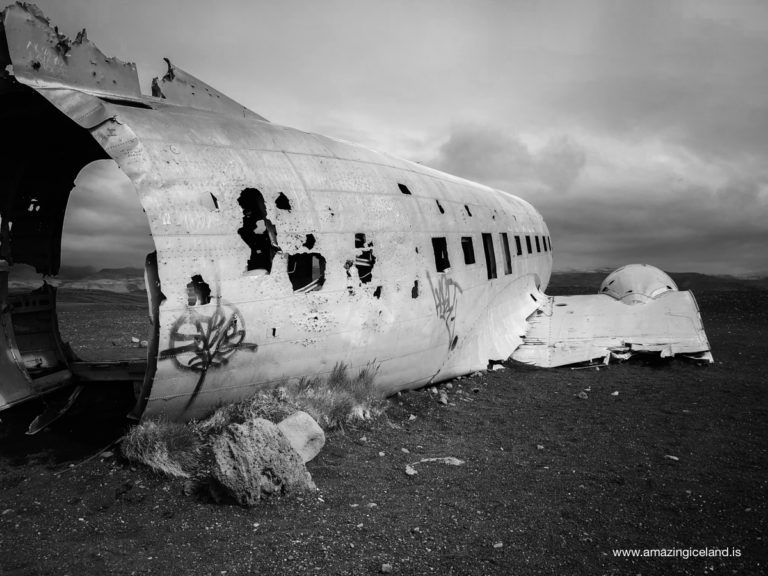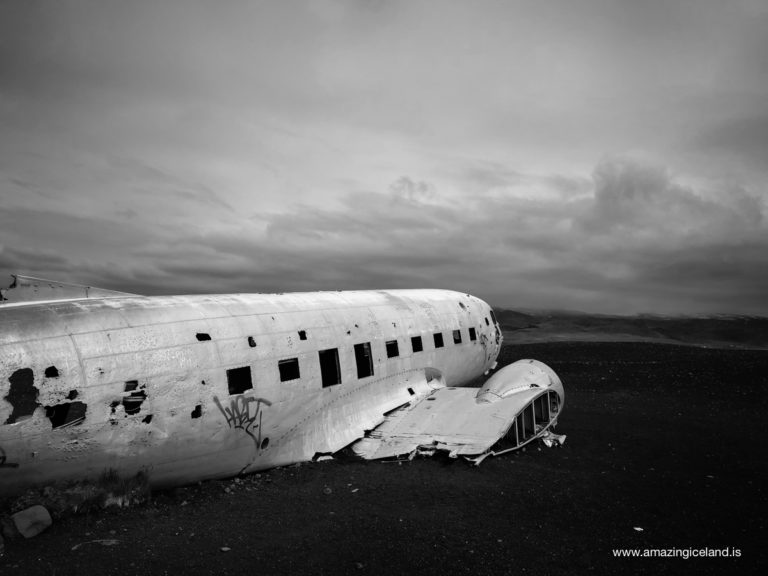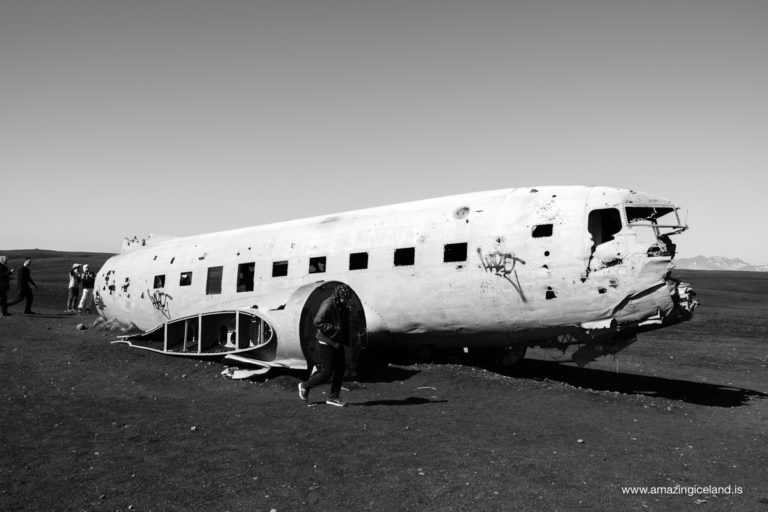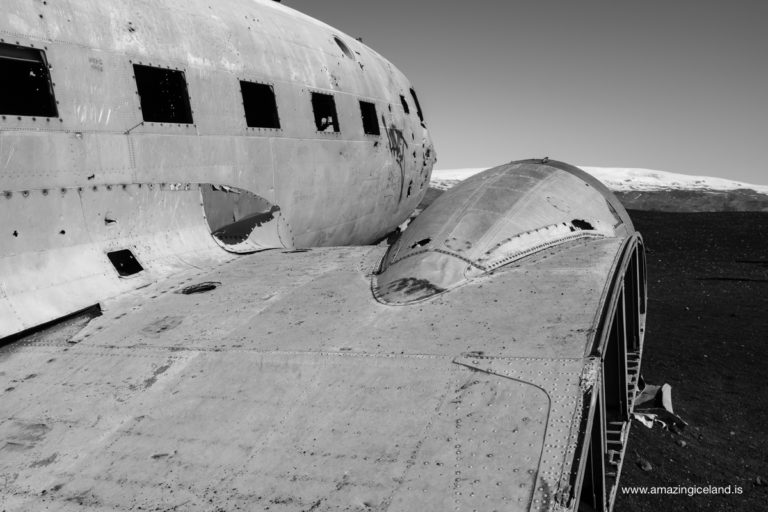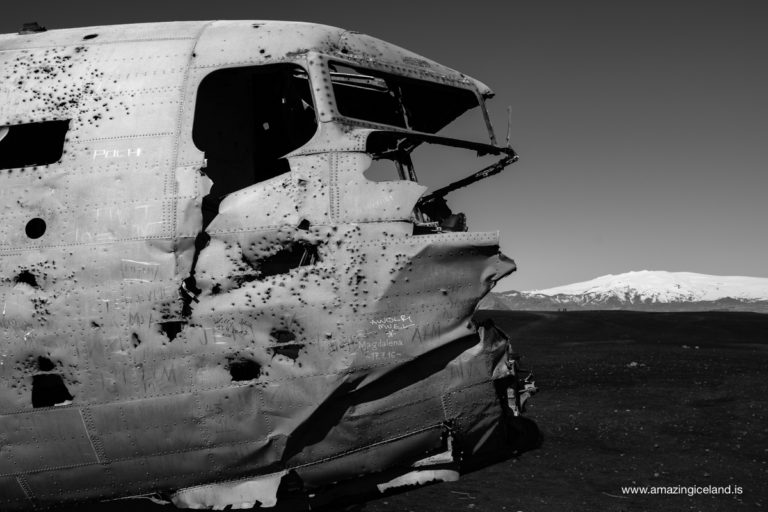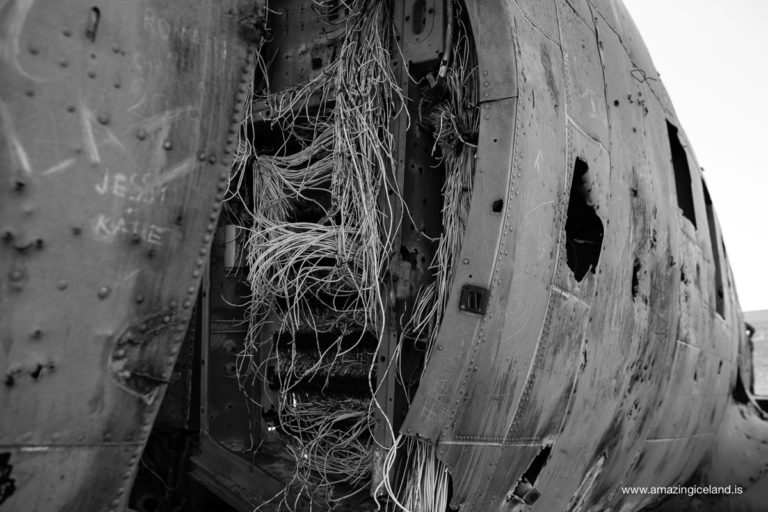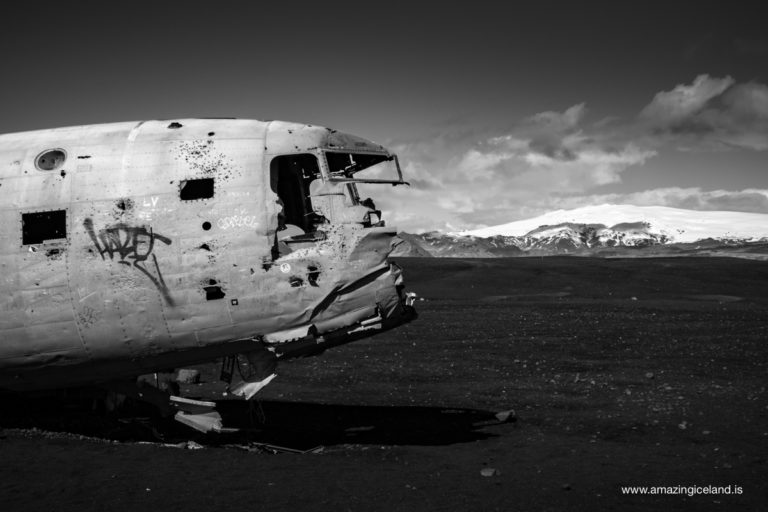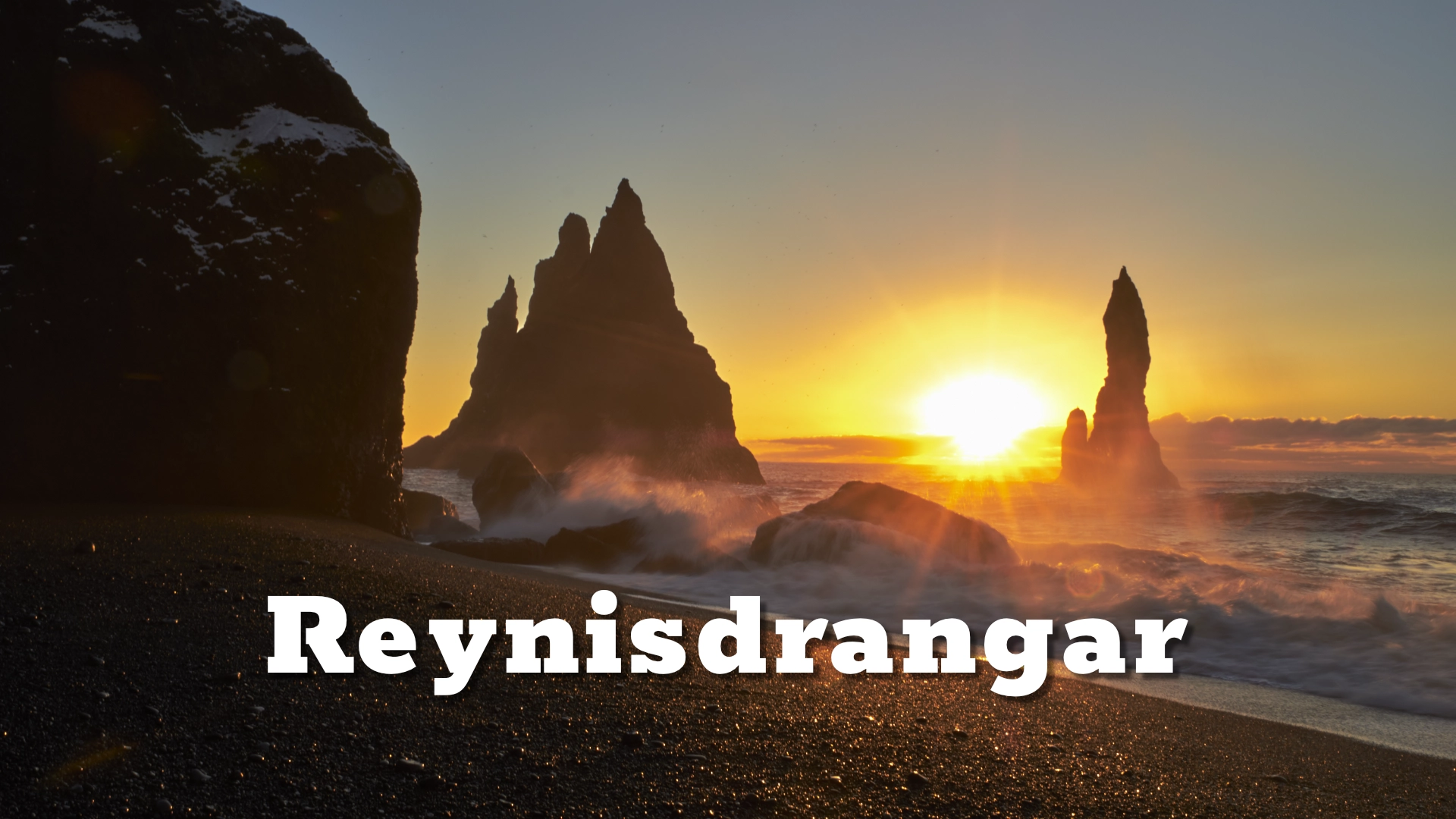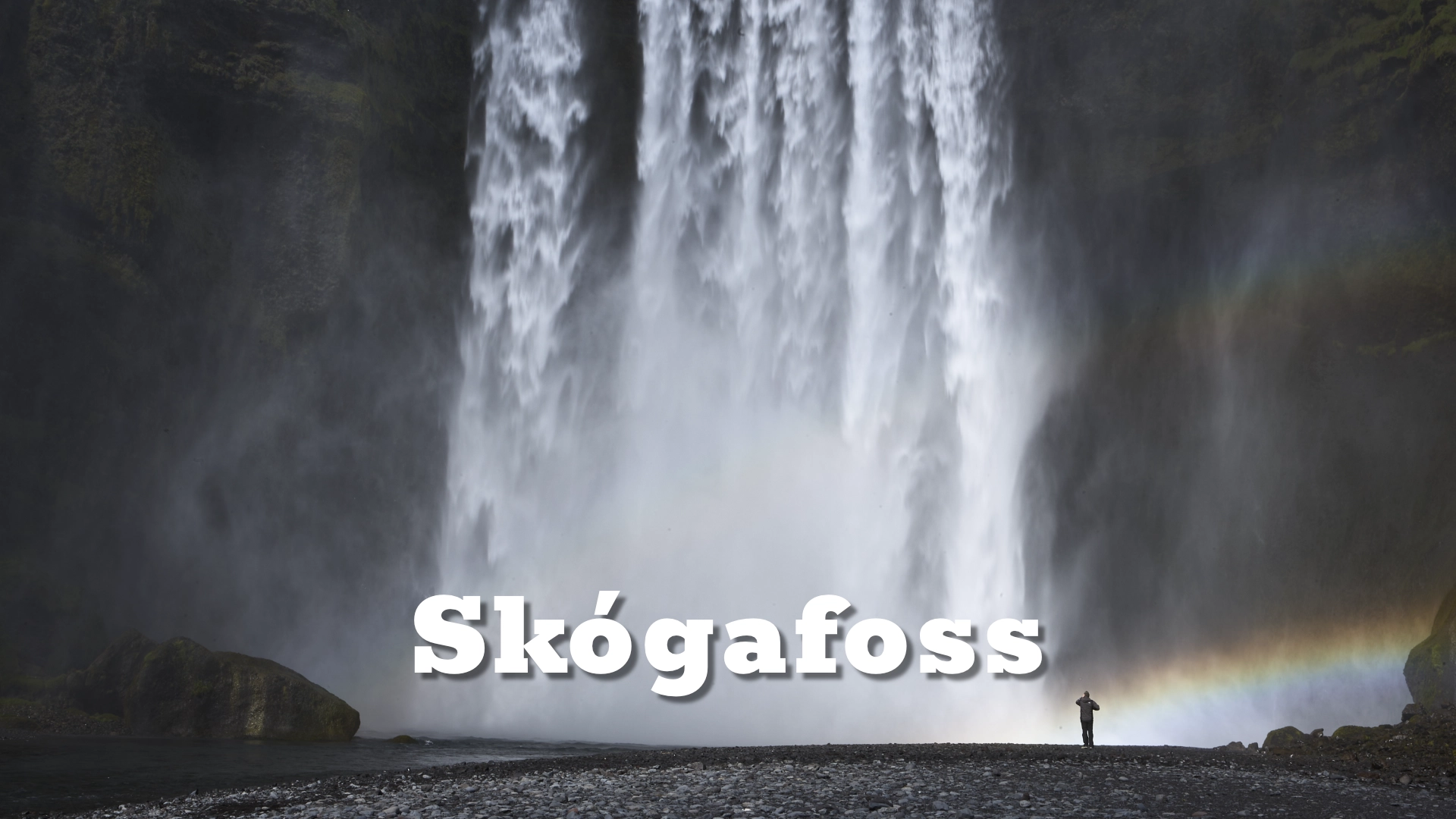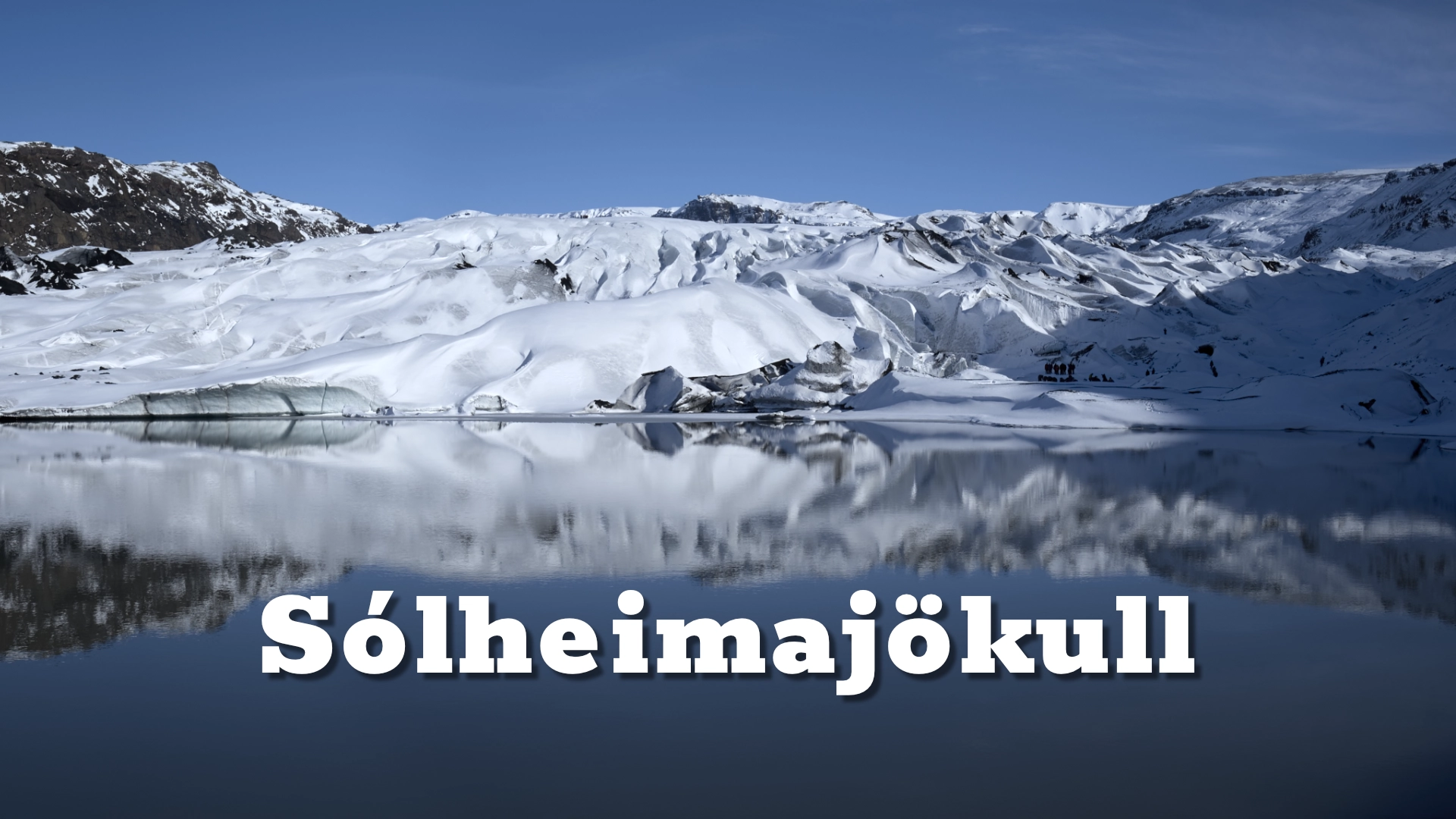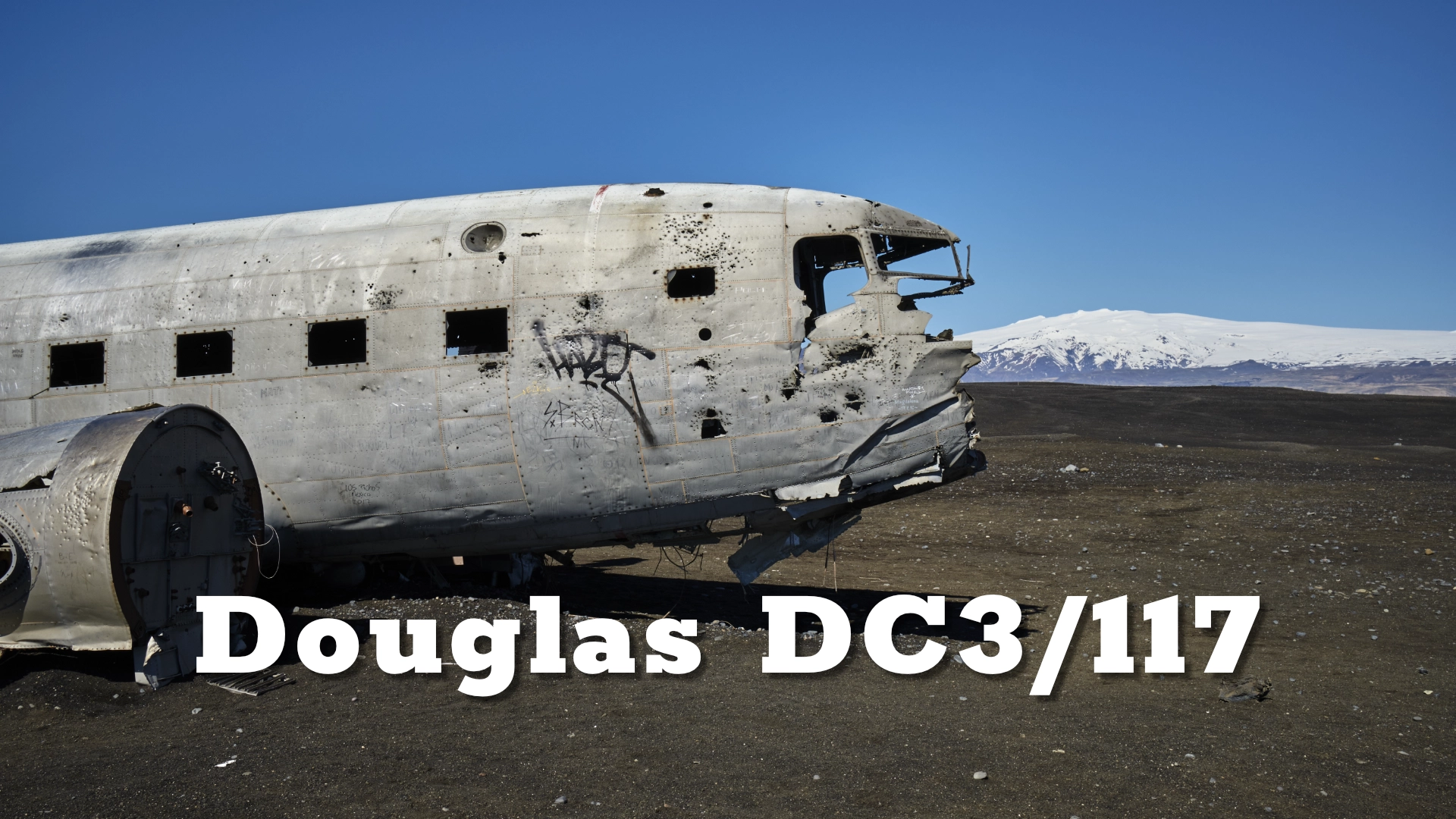
On the shore of Iceland’s black sand Sólheimasandur Beach the rusting hulk of a crashed military plane has been slowly falling apart since 21 of November 1973. What is the true story of this Douglas DC3 or is it C-117 and when did it crash and why. Here is the full story.
The story of DC3 or C-117 plane wreck on Sólheimasandur in Iceland
Many tales of the airplane wreck on Sólheimasandur
There are many stories told about the abandoned DC3 airplane on Sólheimasandur on the south coast of Iceland. You may have seen images of the of this fuselage Douglas DC3 airplane where it sits in the middle of nowhere, but still so close to the Atlantic ocean. All kinds of images of the plane and its surroundings have been popular, especially those with northern lights in the sky. Those images have gone viral in the resent years as the plane wreck has been made popular in videos by musicians as unlike as Sigurrós and Justin Bieber.
You might even have read a blog about how it had to crash land because of a failure by one of its pilot when switching between fuel tanks, making the airplane run out of gas and be forced to land. Some say that it was because of ice on wings that it was forced down. It seems that no one knows the true story. What really happened and why it crashed there on that spot. The story is more dramatic that one would think and there is more mysticism surrounding this incident than meets the eye at first. Here is the true story.
The worlds most famous DC3 plane wreck that is not a DC3
People have been told that the wreck was of a Douglas DC3 and so it states in most all popular blogs that can be found about the airplane. Some told that it in deed was a Douglas DC3 Special, specially built for the US navy as a cargo plane. But the truth is different. The wreck that is sitting on top of its grave in a post-apocalyptic surrounding of vast sand dunes brought down to Sólheimasandur by glacial flooding is in fact a converted Douglas C-117.
In 1951 the U.S. Navy evaluated the Douglas Super DC-3 (USAF YC-47F) and ordered the modernisation of 98 C-47s (USN designation R4D). The aircraft had new outer wing panels, a longer fuselage and tail unit, engine nacelles that fully enclosed the undercarriage, and more powerful R-1820-80 engines. The aircraft was designated R4D-8, which became the C-117D after 1962. The C-117s were operational with the U.S. Navy and Marines until the early 1990s.
The crash date that does not fit.
Most blog sources state that the plane fell down on November 24, 1973, but an Icelandic newspaper report tells a different story. According to Morgunblaðið (the morning paper) published on November 22, 1973 the plane hit the ground on the 21 of November or 3 days earlier than most official sites state. How and why the date of 24th became the official date is unknown, but the true date is the 21st of November 1973.
Iceland independence , WW ll and DC3/C-117
After gaining sovereignty from Denmark in 1918 with the signing of the 25-year Danish-Icelandic Act of Union, Iceland followed a policy of strict neutrality. In 1939, with war imminent in Europe, the German Reich pressed for landing rights for Lufthansa’s aircraft for alleged trans-Atlantic flights. The Icelandic government turned them down.
A British request to establish bases in Iceland for the protection of the vital North Atlantic supply lines after German forces occupied Denmark and Norway in April 1940 also was turned down in accordance with the neutrality policy. Nevertheless, the British government felt that it could not do without bases in Iceland and on 10 May 1940 the people of Reykjavík awoke to the sight of a British invasion force. The government of Iceland protested the invasion but asked the populace to treat the occupying force as guests.
Following talks between British Prime Minister Winston S. Churchill and President Franklin D. Roosevelt of the United States, Iceland agreed to a tripartite treaty under which United States Marines were to relieve the British garrison in Iceland on the condition that all military forces be withdrawn from Iceland immediately upon the conclusion of the war in Europe.
In 1949, Iceland voted to join the North Atlantic Treaty Organization (NATO) among protests about the US militarizing the country, and the base became a Cold War base. On 25 May 1951 the U.S. Air Force reestablished a presence at Keflavik Airport with the establishment of the 1400th Air Base Group. MATS (later MAC and Air Mobility Command) units remained at the airport until the withdrawal of United States military units from Iceland in 2006. The base is regularly visited by the American military, which uses it for emergency landings. In 2016 the United States began preparations to re-occupy the base. In 2017 the United States announced its intention to construct a modern air base on the peninsula.
What was the airplane doing and where was it headed
On top of the presence at Keflavík airbase the US Navy had 4 radar stations in strategically important places in Iceland. One of those places was in the east at Stokksnes close by the town of Hornafjörður. These stations where mostly used to monitor aviation around Iceland but also to search for submarine traffic in the waters in and around the country. These stations that where manned, needed supply and it was from one of such supply cargo trip that the C-117 was coming. The plain was high over Vatnajökull on its way back to the naval air station in Keflavík.
What really happened to the DC3 that is in fact C-117
Iceland has one of the most volatile weather patterns on the planet and at that time it had primitive navigational beacons causing more US military planes to crash on this tiny, Kentucky- sized island than almost anywhere else on Earth.
According to public military records from the Air Force and Navy, from 1941 to 1973, there were 385 US military aviation accidents in Iceland. That’s roughly one accident every 31 days for 33 straight years.
“You have to understand that the weather in Iceland is a very powerful thing. It probably changes faster than anywhere else in the world except the Poles, and that’s why we don’t typically fly over the Poles.” – Lieutenant Gregory Fletcher, a 26-year-old pilot in training said after the accident.
ON 21 of November 1973, the day before thanks giving, the C-117 was flown by captain James Wicke on a routine mission to the east when the weather turned to the worse and temperature plunged to -10°C. The wind gust increased to 96kmh (60Mph), and the carburettor started sucking in ice. As the weather force increased, the fight with heavy turbulence was lost and both engines froze solid and stopped spinning.
Wrapped in heavy fog, the five passengers had no clue as to where they where as they could not even see the tip of the wings when they looked out the window, fearing the worst, that they where going to crash into a mountain and die.
Plane falling over Vatnajökull
As the plane was falling over Vatnajökull, Captain Wicke put out a mayday and tried to restart the engines. The mayday signal was picked up by another airforce plane and immediately 3 Phantom air jets where airborne and 2 helicopters. All ships sailing on the south coast of Iceland where notified as it was not known exactly where the plane would land once a daring decision had been made by Lieutenant Gregory Fletcher, a 26-year-old pilot in training who had only flown 21 hours in a C-117.
Fletcher knowing that a crash into the mountains would kill him and his passengers opted for the better of few bad choices. He was going to try his luck and land on the ocean, giving them a slight better chance to survive as one might possibly live for more than 15 seconds in the cold Atlantic ocean even though the hypothermia would set in so fast. Crashing into the ice cap of the largest glacier in Europe was a certain death.
As the plane kept loosing hight, reaching the coast line Flecher came to realise that they where gliding over “some goddam thing that looked like the moon” He managed to get the plane parallel to the shore line and used the frozen black sand beach as a bumpy runway. He skidded some 27m (90 feet) over the sand dune bending the propellers, crushing the engine cover and rupturing the tanks, but 6 m (20 feet) from the ocean where the plane stopped Fletcher had saved everyones life.
“Smoothest landing I’ve ever been a part of,” said Howard Rowley, an Air Force Master Sergeant.
The big rescue
The nearby farmer, when hearing the crash rushed along with is wife out to his tractor and tried to find his way through the blizzard, down to the beach, not knowing what to find out there. So did other farmers in the vicinity as well as the nearest Search and rescue team in Iceland, in the town of Vik. The Ice-SAR team rushed out to the site in an effort to save those that could be saved. From given informations based on the plane’s speed and height, they had calculated that the plain would land somewhere on Sólheimasandur, somewhere between Mýrdalssandur and the Atlantic ocean. The rescue team from Vík arrived at the crash site just as the survivors were being airlifted away by the Air Force search helicopter, at 14:00, just an hour after the crash. Later on, back at the Keflavík military base those involved where found to have survived without any injury, actually with out a scratch. The same could not be said about the plane it self.
The stripping of the plane
Immediately the stripping of the plane began and the SAR was given the 800 litres of gasoline that the C-117 was still carrying. This was enough to run snowmobiles and rescue trucks for years to come. The wings were being sawed off, the control deck was being dismantled, and the engines were being hoisted out. Every thing salvageable in the C-117 worth something was stripped of the plane. Two days after the crash the fuselage was like a skeleton in the black apocalyptic desert and the US military simply left the 10,000-pound shell littered on the beach and walked away.
Why is the DC3 or C-117 still there on Sólheimasandur
This was not unique, this happened all the time. According to Friðþór Eydal, who served as the public affairs officer for the US- commandedIcelandic Defence Forcefrom 1983 to 2006, as part of theStatus of Forces Agreementbetween the two nations, there was an understanding that if an American plane crashed in Iceland, the US would agree to pay 85 percent of the recovery cost, but the Icelandic government would be responsible for actually removing it.
“That scenario would only ever take place if a landowner led a claim to remove the wreck,” Eydal said. “And in a place like Iceland, that almost never happened.”
Why? According to Eydal, there are two reasons. First, on an island that’s 80 percent uninhabited and where more than 60 percent of the land is covered by glaciers and Second, because of its harsh climate and limited natural resources, Iceland has to import most everything. As a result, Icelanders tend to waste no usable materials and creatively repurpose what little they have. So once these machines fell and the military turned away, entrepreneurial locals secretly transformed their remains into roofs, fences, and other household items.
Music Videos made by the plane wreck:
Sigurrós – 2006 — Heima : https://youtu.be/EuftN2ViiN4?si=E3VXMm8uk6X1i8r-
Sólstafir – 2012 — Fjara : https://youtu.be/A6j7mUxGz20?si=87fHH96SIFWoli75
Shah Rukh Khan – 2015 — Gerua: https://youtu.be/AEIVhBS6baE?si=ZS9jfDXVG-O3386B
Justin Bieber – 2015 — I’ll Show You: https://youtu.be/PfGaX8G0f2E?si=VdNFXE_p8l13bi_g
Interesting facts:
The Locomotive Elite
What do Donald Trump and Iceland’s Locomotive Elite have in common?
Far more than you think.
In The Locomotive Elite, you’ll uncover how a tiny clique in Iceland captured extensive control—of banks, courts, media, and even the central bank.
For decades they ruled, first democratically, then through corruption and in the end through crime, enriching themselves and their cronies while dismantling oversight.
The result?
One of the most spectacular financial collapses in modern history.



